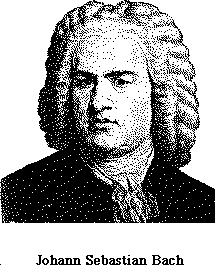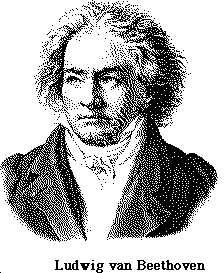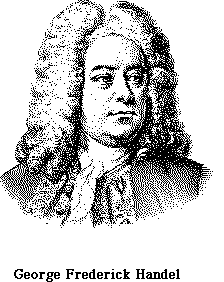













|
The Dream Team |







|
|
|
|
|
|
 |
|
 |
|
 |
|
 |
|
 |
|
|
|
|
|
1. Fugue in
G minor
2. Toccata and Fugue in d minor 3. Two-part Invention No. 4 4. Wachet auf |
|
|
1. Symphony
No. 5 in c minor
2. Piano Sonata - "Waldstein" 3. Piano Sonata - "Moonlight" |
|
|
1. Hallelujah
Chorus
2. "Sing Unto God" from Judas Maccabaeus 3. "Arrival of Queen Sheba" from Solomon |
|
|
1. Symphony
#94
2. Piano Sonata No. 31 in G 3. Gypsy Rondo |
|
|
1. Eine
Kleine Nachtmusik
2. Sonata in C, k. 19d 3. Overture to Marriage of Figaro |
|
1600-1750 |
| The Baroque period in music history
is dated from 1600 to 1750. The term "Baroque", refers to the type
of architectural style that was popular during this particular period of
time. The architecture was very fancy and ornate. Buildings and works
of art were very delicately decorated and trimmings of twists and turns.
Composers of the Baroque Period copied the architectural style by
composing music that was very ornate and full of twisting and turning
sounds.
A few of the most famous composers
of this period were Bach, Handel,
|
|
1750-1827 |
| 'Classic' is one of the periods
in music music history - the one that comes between Baroque and Romantic.
We call the "Classic style" all the music composed from around 1750 to
the death of Beethoven in 1827. Perhaps you don't listen to a Haydn
symphony and immediately think, "Party Time!," but people did in those
days. While fugues and other old-fashioned techniques were used by
Haydn, Mozart and Beethoven, their music shows the essential requirements
of the classical style. People could make sense of Mozart's music,
without being turned off. It was to the genius of Mozart and Haydn
that they were able to work within the confines of public taste and yet
produce music that showed a remarkable spirit of originality. Beethoven
pushed the classical style to its limits and beyond, putting energy into
his later works that puzzled those who still saw music as "good listening"
but exciting those who believed it to be a way for self-expression.
|
|
1800's |
| During the Romantic Period, composers
began writing according to their emotions. During the classic period, form
was the most important element of the music. During the Romantic
Era, composers wanted to write music that was more free, that would perhaps
paint a sound picture, or make the listeners feel a certain emotion, such
as joy, sadness, or fear. Beethoven is credited with starting this trend
in music. He is the only composer that lived during both the Class
and Romantic periods. Many composers also began writing music that
was patriotic to their own country. This is called Nationalism.
Other Composers Other composers that lived during the Romantic Era were Berlioz, from France, Schubert, Schumann, Mendelssohn, and Wagner from Germany, Chopin from Poland, and Liszt from Hungary. |
|
Created by... Lori Vaas, Cortez Castilla, Dennis May
|